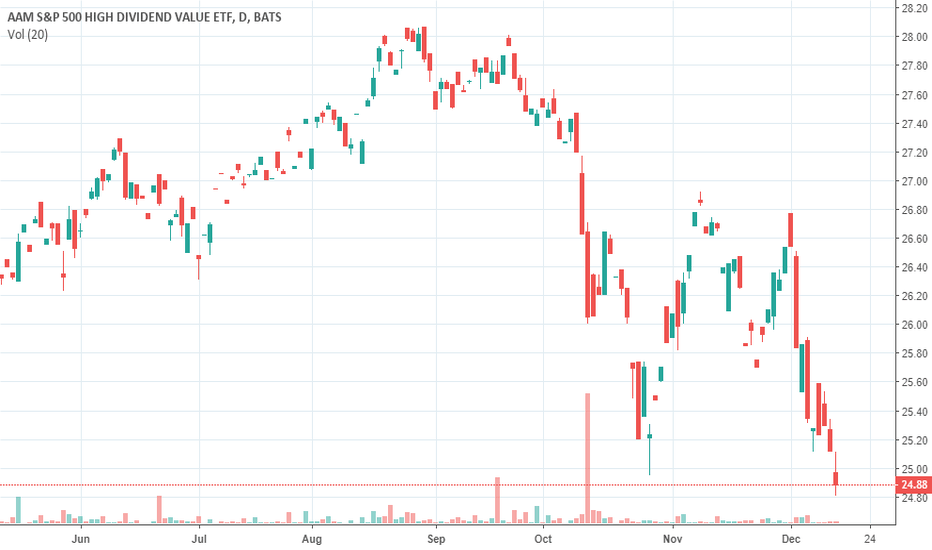Key stats
About AAM S&P 500 High Dividend Value ETF
Home page
Inception date
Nov 28, 2017
Structure
Open-Ended Fund
Replication method
Physical
Dividend treatment
Distributes
Distribution tax treatment
Qualified dividends
Income tax type
Capital Gains
Max ST capital gains rate
39.60%
Max LT capital gains rate
20.00%
Primary advisor
Advisors Asset Management, Inc.
Distributor
Quasar Distributors LLC
SPDV follows an index of US companies that screens for fundamental factors. Index construction begins by selecting companies from the S&P500 index with high, positive dividend and free-cash-flow yields. Outliers are removed from the selection pool. Using a statistical normalization model, each security is scored based on its dividend and free-cash-flow yields. The top five constituents are selected from each sector and weighted equally. Diversifying the portfolio across economic sectors in this manner should help avoid value traps, though it also means that SPDV will underweight the largest sectors while overweighting the smallest. The index is reconstituted semi-annually.
Related funds
Classification
What's in the fund
Exposure type
Finance
Utilities
Stock breakdown by region
Top 10 holdings
Summarizing what the indicators are suggesting.
Oscillators
Neutral
SellBuy
Strong sellStrong buy
Strong sellSellNeutralBuyStrong buy
Oscillators
Neutral
SellBuy
Strong sellStrong buy
Strong sellSellNeutralBuyStrong buy
Summary
Neutral
SellBuy
Strong sellStrong buy
Strong sellSellNeutralBuyStrong buy
Summary
Neutral
SellBuy
Strong sellStrong buy
Strong sellSellNeutralBuyStrong buy
Summary
Neutral
SellBuy
Strong sellStrong buy
Strong sellSellNeutralBuyStrong buy
Moving Averages
Neutral
SellBuy
Strong sellStrong buy
Strong sellSellNeutralBuyStrong buy
Moving Averages
Neutral
SellBuy
Strong sellStrong buy
Strong sellSellNeutralBuyStrong buy
Displays a symbol's price movements over previous years to identify recurring trends.
Frequently Asked Questions
An exchange-traded fund (ETF) is a collection of assets (stocks, bonds, commodities, etc.) that track an underlying index and can be bought on an exchange like individual stocks.
SPDV trades at 32.08 USD today, its price has risen 0.34% in the past 24 hours. Track more dynamics on SPDV price chart.
SPDV net asset value is 32.07 today — it's fallen 0.40% over the past month. NAV represents the total value of the fund's assets less liabilities and serves as a gauge of the fund's performance.
SPDV assets under management is 67.14 M USD. AUM is an important metric as it reflects the fund's size and can serve as a gauge of how successful the fund is in attracting investors, which, in its turn, can influence decision-making.
SPDV price has risen by 0.26% over the last month, and its yearly performance shows a 7.09% increase. See more dynamics on SPDV price chart.
NAV returns, another gauge of an ETF dynamics, have risen by −0.40% over the last month, have fallen by −0.40% over the last month, showed a 0.09% increase in three-month performance and has increased by 11.13% in a year.
NAV returns, another gauge of an ETF dynamics, have risen by −0.40% over the last month, have fallen by −0.40% over the last month, showed a 0.09% increase in three-month performance and has increased by 11.13% in a year.
SPDV fund flows account for 5.30 M USD (1 year). Many traders use this metric to get insight into investors' sentiment and evaluate whether it's time to buy or sell the fund.
Since ETFs work like an individual stock, they can be bought and sold on exchanges (e.g. NASDAQ, NYSE, EURONEXT). As it happens with stocks, you need to select a brokerage to access trading. Explore our list of available brokers to find the one to help execute your strategies. Don't forget to do your research before getting to trading. Explore ETFs metrics in our ETF screener to find a reliable opportunity.
SPDV invests in stocks. See more details in our Analysis section.
SPDV expense ratio is 0.29%. It's an important metric for helping traders understand the fund's operating costs relative to assets and how expensive it would be to hold the fund.
No, SPDV isn't leveraged, meaning it doesn't use borrowings or financial derivatives to magnify the performance of the underlying assets or index it follows.
In some ways, ETFs are safe investments, but in a broader sense, they're not safer than any other asset, so it's crucial to analyze a fund before investing. But if your research gives a vague answer, you can always refer to technical analysis.
Today, SPDV technical analysis shows the buy rating and its 1-week rating is buy. Since market conditions are prone to changes, it's worth looking a bit further into the future — according to the 1-month rating SPDV shows the buy signal. See more of SPDV technicals for a more comprehensive analysis.
Today, SPDV technical analysis shows the buy rating and its 1-week rating is buy. Since market conditions are prone to changes, it's worth looking a bit further into the future — according to the 1-month rating SPDV shows the buy signal. See more of SPDV technicals for a more comprehensive analysis.
Yes, SPDV pays dividends to its holders with the dividend yield of 3.82%.
SPDV trades at a premium (0.04%).
Premium/discount to NAV expresses the difference between the ETF’s price and its NAV value. A positive percentage indicates a premium, meaning the ETF trades at a higher price than the calculated NAV. Conversely, a negative percentage indicates a discount, suggesting the ETF trades at a lower price than NAV.
Premium/discount to NAV expresses the difference between the ETF’s price and its NAV value. A positive percentage indicates a premium, meaning the ETF trades at a higher price than the calculated NAV. Conversely, a negative percentage indicates a discount, suggesting the ETF trades at a lower price than NAV.
SPDV shares are issued by Sun Life Financial, Inc.
SPDV follows the S&P 500 Dividend and Free Cash Flow Yield Index. ETFs usually track some benchmark seeking to replicate its performance and guide asset selection and objectives.
The fund started trading on Nov 28, 2017.
The fund's management style is passive, meaning it's aiming to replicate the performance of the underlying index by holding assets in the same proportions as the index. The goal is to match the index's returns.
